Tracing the Provenance of Long-Range Transported Dust Deposition in Cryospheric Basins of the Northeast Tibetan Plateau: REEs and Trace Element Evidences
Abstract
1. Introduction
2. Materials and Methods
2.1. Sampling
2.2. Rees and Trace Elements Analyzed
2.3. Tem-Edx Measurement
2.4. Quality Control of Chemical Analysis
2.5. Data Analysis and Geochemical Parameters
3. Results and Discussion
3.1. Geochemical Compositions of Aeolian Materials in Different Locations Of the NETP Glaciers and Snowpacks
3.2. LRT Dust in NETP Region and Its Relationship with Large Scale Regional Atmospheric Circulation
4. Conclusions
Author Contributions
Funding
Acknowledgments
Conflicts of Interest
References
- Sun, Y.; Tada, R.; Chen, J.; Liu, Q.; Toyoda, S.; Tani, A.; Ji, J.; Isozaki, Y. Tracing the provenance of fine-grained dust deposited on the central Chinese Loess Plateau. Geophys. Res. Lett. 2008, 35. [Google Scholar] [CrossRef]
- Nie, J.; Stevens, T.; Rittner, M.; Stockli, D.; Garzanti, E.; Limonta, M.; Bird, A.; Andò, S.; Vermeesch, P.; Saylor, J.; et al. Loess plateau storage of northeastern Tibetan plateau-derived Yellow River sediment. Nat. Commun. 2015, 6, 8511. [Google Scholar] [CrossRef] [PubMed]
- Hu, F.; Yang, X. Geochemical and geomorphological evidence for the provenance of aeolian deposits in the Badain Jaran Desert, northwestern China. Quat. Sci. Rev. 2016, 131, 179–192. [Google Scholar] [CrossRef]
- Pullen, A.; Kapp, P.; McCallister, A.T.; Chang, H.; Gehrels, G.E.; Garzione, C.N.; Heermance, R.V.; Ding, L. Qaidam Basin and northern Tibetan Plateau as dust sources for the Chinese Loess Plateau and paleoclimatic implications. Geology 2011, 39, 1031–1034. [Google Scholar] [CrossRef]
- Kapp, P.; Pelletier, J.D.; Rohrmann, A.; Heermance, R.; Russell, J.; Ding, L. Wind erosion in the Qaidam basin, central Asia: Implications for tectonics, paleoclimate, and the source of the Loess Plateau. GsA Today 2011, 21, 4–10. [Google Scholar] [CrossRef]
- Maher, B.A.; Mutch, T.J.; Cunningham, D. Magnetic and geochemical characteristics of Gobi Desert surface sediments: Implications for provenance of the Chinese Loess Plateau. Geology 2009, 37, 279–282. [Google Scholar] [CrossRef]
- Sun, J. Provenance of loess material and formation of loess deposits on the Chinese Loess Plateau. Earth Planet. Sci. Lett. 2002, 203, 845–859. [Google Scholar] [CrossRef]
- Maher, B.A.; Prospero, J.M.; Mackie, D.; Gaiero, D.; Hesse, P.P.; Balkanski, Y. Global connections between aeolian dust, climate and ocean biogeochemistry at the present day and at the last glacial maximum. Earth Sci. Rev. 2010, 99, 61–97. [Google Scholar] [CrossRef]
- Ding, Z.L.; Sun, J.M.; Yang, S.L.; Liu, T.S. Geochemistry of the Pliocene red clay formation in the Chinese Loess Plateau and implications for its origin, source provenance and paleoclimate change. Geochim. Cosmochim. Acta 2001, 65, 901–913. [Google Scholar] [CrossRef]
- Uno, I.; Eguchi, K.; Yumimoto, K.; Takemura, T.; Shimizu, A.; Uematsu, M.; Liu, Z.; Wang, Z.; Hara, Y.; Sugimoto, N. Asian dust transported one full circuit around the globe. Nat. Geosci. 2009, 2, 557–560. [Google Scholar]
- Creamean, J.M.; Suski, K.J.; Rosenfeld, D.; Cazorla, A.; DeMott, P.J.; Sullivan, R.C.; White, A.B.; Ralph, F.M.; Minnis, P.; Comstock, J.M.; et al. Dust and biological aerosols from the Sahara and Asia influence precipitation in the western US. Science 2013, 339, 1572–1578. [Google Scholar] [CrossRef] [PubMed]
- Shao, Y.; Wyrwoll, K.H.; Chappell, A.; Huang, J.; Lin, Z.; McTainsh, G.H.; Mikami, M.; Tanaka, T.Y.; Wang, X.; Yoon, S. Dust cycle: An emerging core theme in Earth system science. Aeolian Res. 2011, 2, 181–204. [Google Scholar] [CrossRef]
- Xu, J.; Yu, G.; Kang., S.; Hou, S.; Zhang, Q.; Ren, J.; Qin, D. Sr–Nd isotope evidence for modern aeolian dust sources in mountain glaciers of western China. J. Glaciology 2012, 58, 859–865. [Google Scholar] [CrossRef]
- Dong, Z.; Kang, S.; Qin, D.; Li, Y.; Wang, X.; Ren, J.; Li, X.; Yang, J.; Qin, X. Provenance of cryoconite deposited on the glaciers of the Tibetan Plateau: New insights from Nd-Sr isotopic composition and size distribution. J. Geophys. Res. 2016, 121, 7371–7382. [Google Scholar] [CrossRef]
- Dong, Z.; Qin, D.; Kang, S.; Liu, Y.; Li, Y.; Huang, J.; Qin, X. Individual particles of cryoconite deposited on the mountain glaciers of the Tibetan Plateau: Insights into chemical composition and sources. Atmos. Environ. 2016, 138, 114–124. [Google Scholar] [CrossRef]
- Wei, T.; Dong, Z.; Kang, S.; Qin, X.; Guo, Z. Geochemical evidence for sources of surface dust deposited on the Laohugou glacier, Qilian Mountains. Appl. Geochem. 2017, 79, 1–8. [Google Scholar] [CrossRef]
- Wu, G.; Zhang, C.; Gao, S.; Yao, T.; Tian, L.; Xia, D. Element composition of dust from a shallow Dunde ice core, Northern China. Glob. Planet. Change 2009, 67, 186–192. [Google Scholar] [CrossRef]
- Piper, D.Z.; Bau, M. Normalized rare earth elements in water, sediments, and wine: Identifying sources and environmental redox conditions. Am. J. Anal. Chem. 2013, 4, 69–83. [Google Scholar] [CrossRef]
- Henderson, P. Rare Earth Element Geochemistry; Elsevier Science: Amsterdam, The Netherlands, 1984; pp. 15–117. [Google Scholar]
- Acker, J.G.; Leptoukh, G. Online Analysis Enhances Use of NASA Earth Science Data. Eos Trans. Am. Geophys. Union 2007, 88, 14–17. [Google Scholar] [CrossRef]
- Liu, Y.; Hou, S.; Zhang, Y. The acid cleaning method of labware for trace element analysis in snow and ice samples. Sci. Cold Arid Reg 2009, 1, 502–508. [Google Scholar]
- Zinatloo-Ajabshir, S.; Salavati-Niasari, M. Facile route to synthesize zirconium dioxide (ZrO2) nanostructures: Structural, optical and photocatalytic studies. J. Mol. Liq. 2016, 216, 545–551. [Google Scholar] [CrossRef]
- Niemi, J.V.; Saarikoski, S.; Tervahattu, H.; Mäkelä, T.; Hillamo, R.; Vehkamäki, H.; Sogacheva, L.; Kulmala, M. Changes in background aerosol composition in Finland during polluted and clean periods studied by TEM/EDX individual particle analysis. Atmos. Chem. Phys. 2006, 6, 5049–5066. [Google Scholar] [CrossRef]
- Taylor, S.R.; McLennan, S.M. The Continental Crust: Its Composition and Evolution; Blackwell Scientific Publications: Hoboken, NJ, USA, 1985; pp. 1–328. [Google Scholar]
- McLennan, S.M.; Hemming, S.; McDaniel, D.K.; Hanson, G.N. Geochemical approaches to sedimentation, provenance, and tectonics. Geol. Soc. Am. Special Pap. 1993, 284, 21–40. [Google Scholar]
- Cullers, R.L.; Podkovyrov, V.N. The source and origin of terrigenous sedimentary rocks in the Mesoproterozoic Ui group, southeastern Russia. Precambrian Res. 2002, 117, 157–183. [Google Scholar] [CrossRef]
- Pearce, J.A.; Norry, M.J. Petrogenetic implications of Ti, Zr, Y, and Nb variations in volcanic rocks. Contrib. Mineral. Petrol. 1979, 69, 33–47. [Google Scholar] [CrossRef]
- Turner, S.; Rushmer, T.; Reagan, M.; Moyen, J.-F. Heading down early on? Start subduction on Earth. Geology 2014, 42, 139–142. [Google Scholar] [CrossRef]
- Furnes, H.; Dilek, Y.; deWit, M. Precambrian greenstone sequences represent different ophiolite types. Gondwana Res. 2015, 27, 649–685. [Google Scholar] [CrossRef]
- Zhang, X.Y.; Arimoto, R.; An, Z.S. Dust emission from Chinese desert sources linked to variation in atmospheric circulation. J. Geophys. Res. 1997, 102, 28041–28047. [Google Scholar] [CrossRef]
- Guy, A.; Schulmann, K.; Clauer, N.; Hasalová, P.; Seltmann, R.; Armstrong, R.; Lexa, O.; Benedicto, A. Late Paleozoic–Mesozoic tectonic evolution of the Trans-Altai and South Gobi Zones in southern Mongolia based on structural and geochronological data. Gondwana Res. 2014, 25, 309–337. [Google Scholar] [CrossRef]
- Hanzl, P.; Bat-Ulzi, D.; Rejchrt, M.; Košler, J.; Bolormaa, K.; Hrdličková, K. Geology and geochemistry of the Palaeozoic plutonic bodies of the Trans-Altay Gobi, SW Mongolia: Implications for magmatic processes in an accreted volcanic-arc system. J. Geosci. 2008, 53, 201–234. [Google Scholar]
- Yang, X.; Zhu, B.; White, P.D. Provenance of aeolian sediment in the Taklamakan Desert of western China, inferred from REE and major-elemental data. Quat. Int. 2007, 175, 71–85. [Google Scholar] [CrossRef]
- Ferrat, M.; Weiss, D.J.; Strekopytov, S.; Dong, S.; Chen, H.; Najorka, J.; Sun, Y.; Gupta, S.; Tada, R.; Sinha, R. Improved provenance tracing of Asian dust sources using rare earth elements and selected trace elements for palaeomonsoon studies on the eastern Tibetan Plateau. Geochim. Cosmochim. Acta 2011, 75, 6374–6399. [Google Scholar] [CrossRef]
- Li, C.; Kang, S.; Zhang, Q. Elemental composition of Tibetan Plateau top soils and its effect on evaluating atmospheric pollution transport. Environ. Pollut. 2009, 157, 2261–2265. [Google Scholar] [CrossRef] [PubMed]
- Yang, S.F.; Chen, H.L.; Ji, D.W.; Zhi-long, L.; Chuan-wan, D.; Cheng-zao, J.; Guo-qi, W. Geological process of early to middle Permian magmatism in Tarim Basin and its geodynamic significance. Geol. J. China Univ. 2005, 11, 504–511. (In Chinese) [Google Scholar]
- Song, S.; Yang, J.; Liou, J.G.; Wu, C.; Shi, R.; Xu, Z. Petrology, geochemistry and isotopic ages of eclogites from the Dulan UHPM Terrane, the North Qaidam, NW China. Lithos 2003, 70, 195–211. [Google Scholar] [CrossRef]
- Dan, W.; Li, X.H.; Wang, Q.; Wang, X.-C.; Liu, Y. Neoproterozoic S-type granites in the Alxa Block, westernmost North China and tectonic implications: In situ zircon U-Pb-Hf-O isotopic and geochemical constraints. Am. J. Sci. 2014, 314, 110–153. [Google Scholar] [CrossRef]
- Sun, J.; Zhang, M.; Liu, T. Spatial and temporal characteristics of dust storms in China and its surrounding regions, 1960–1999: Relations to source area and climate. J. Geophys. Res. 2001, 106, 10325–10333. [Google Scholar] [CrossRef]
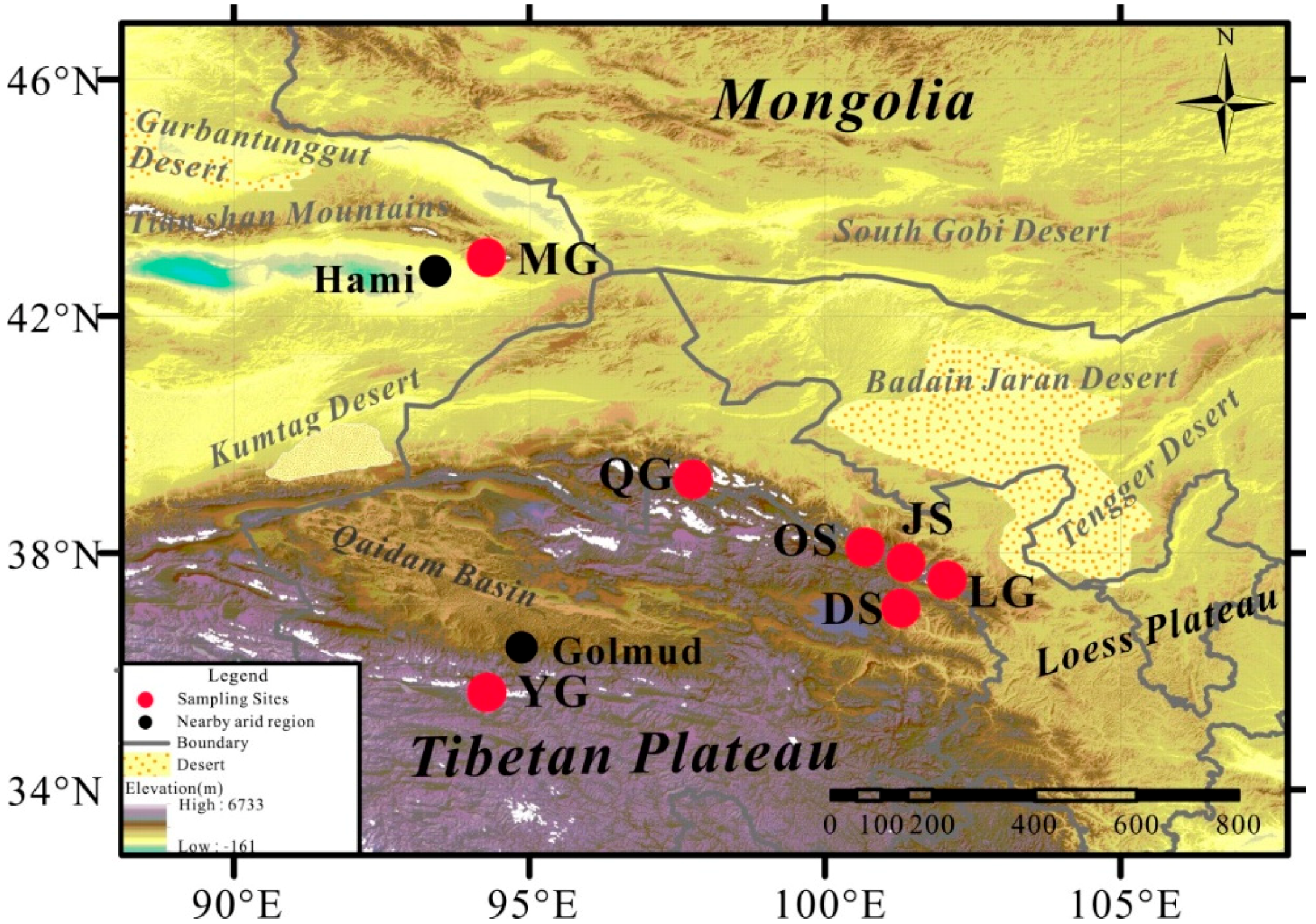
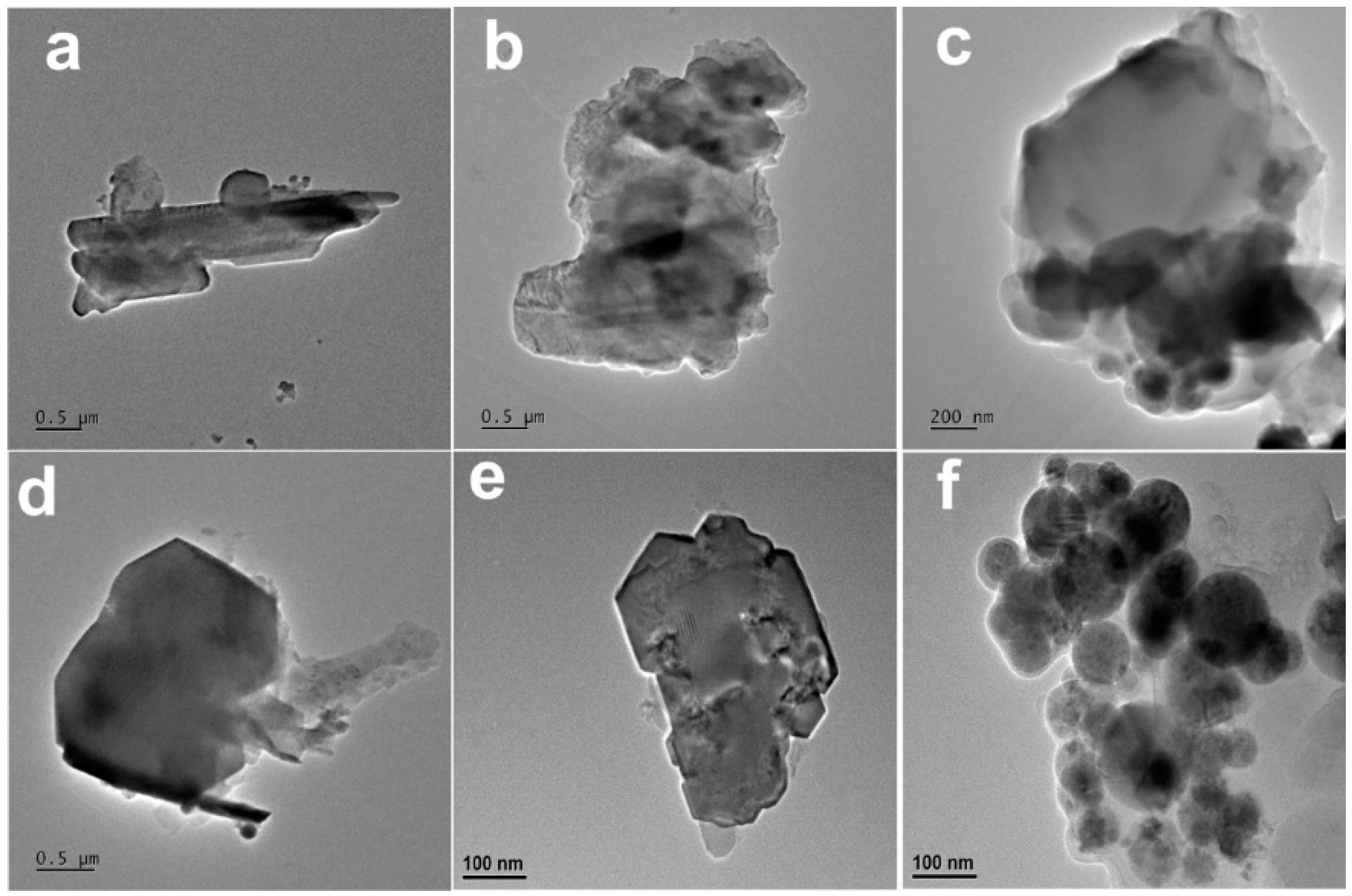
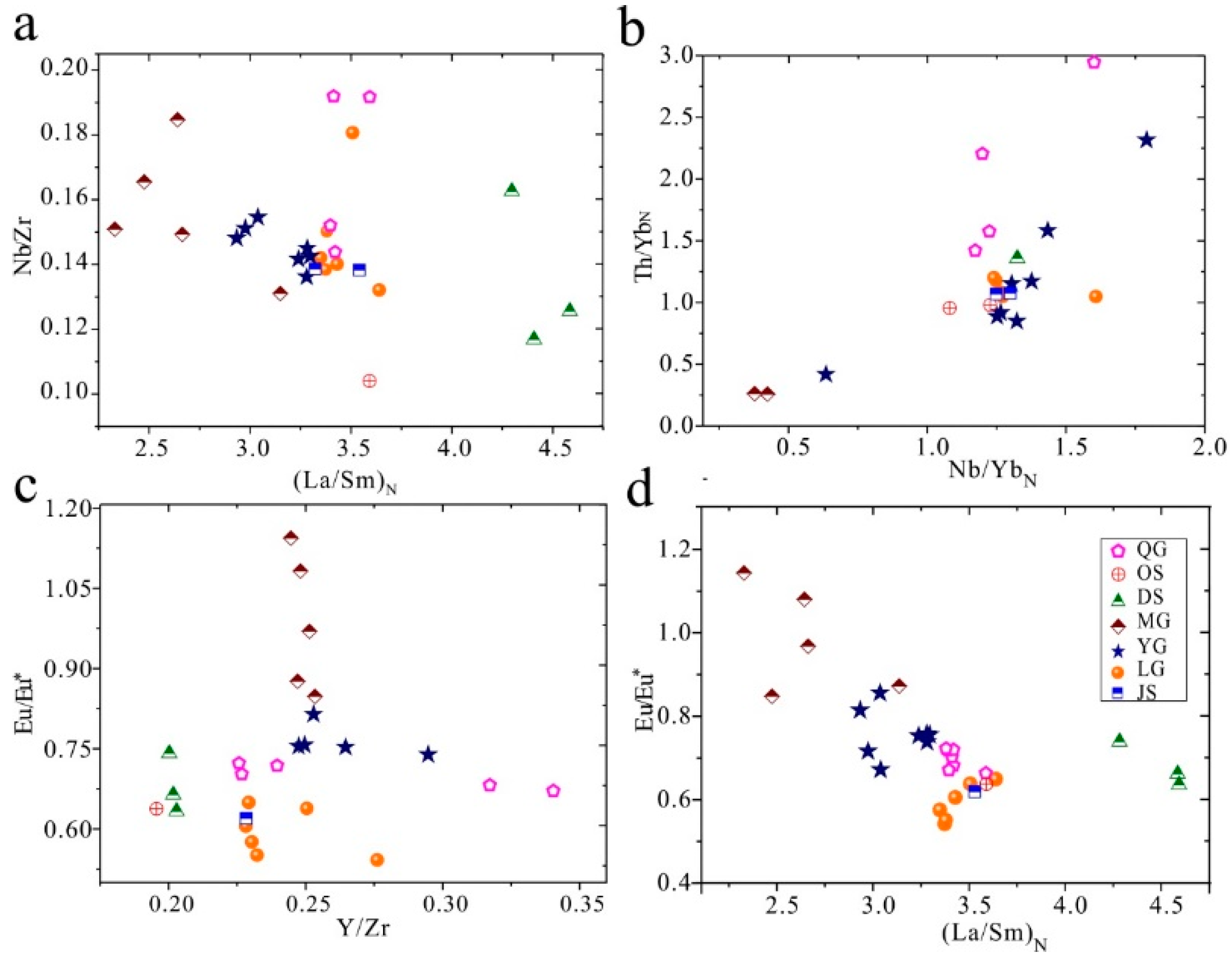
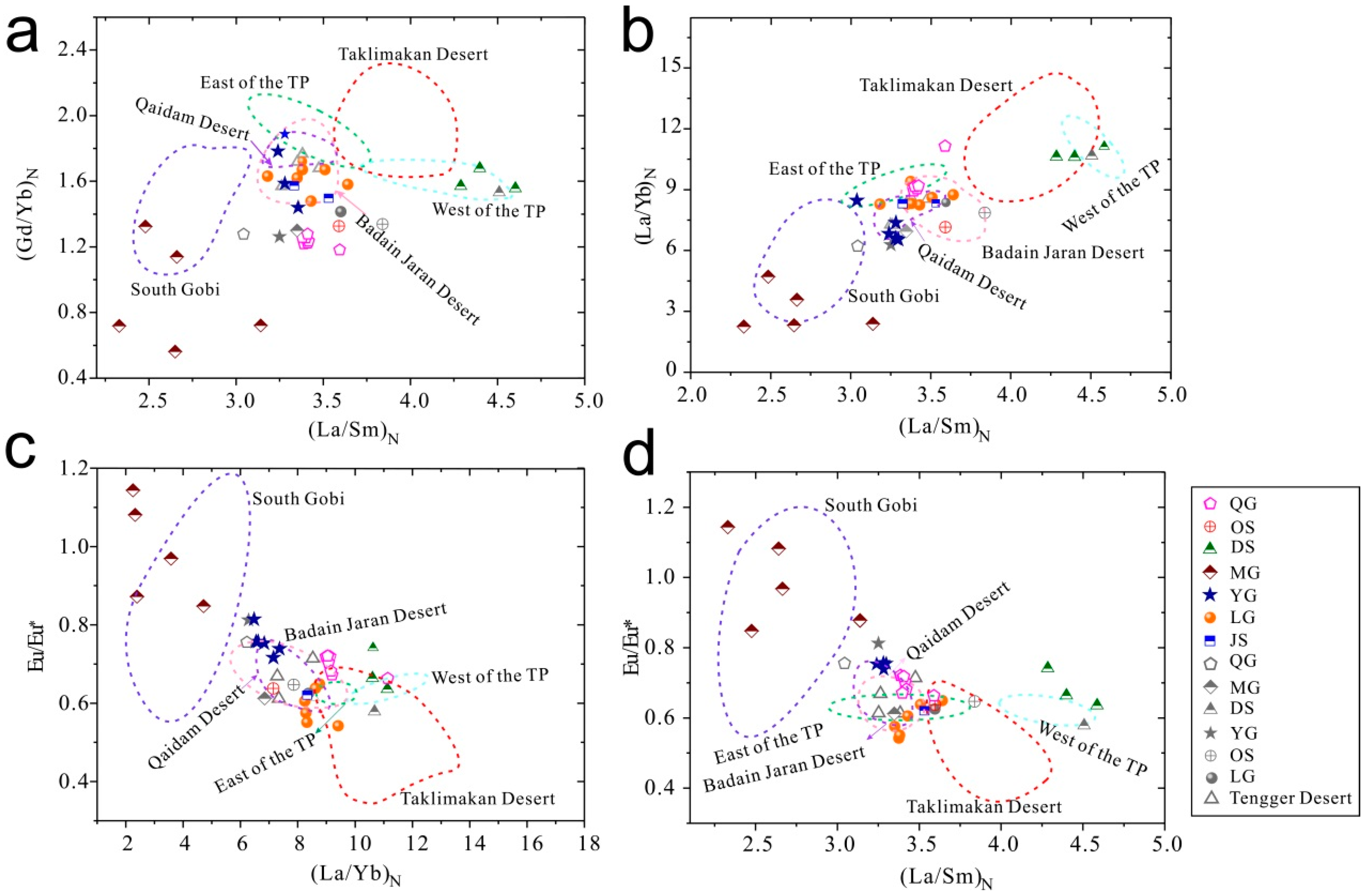
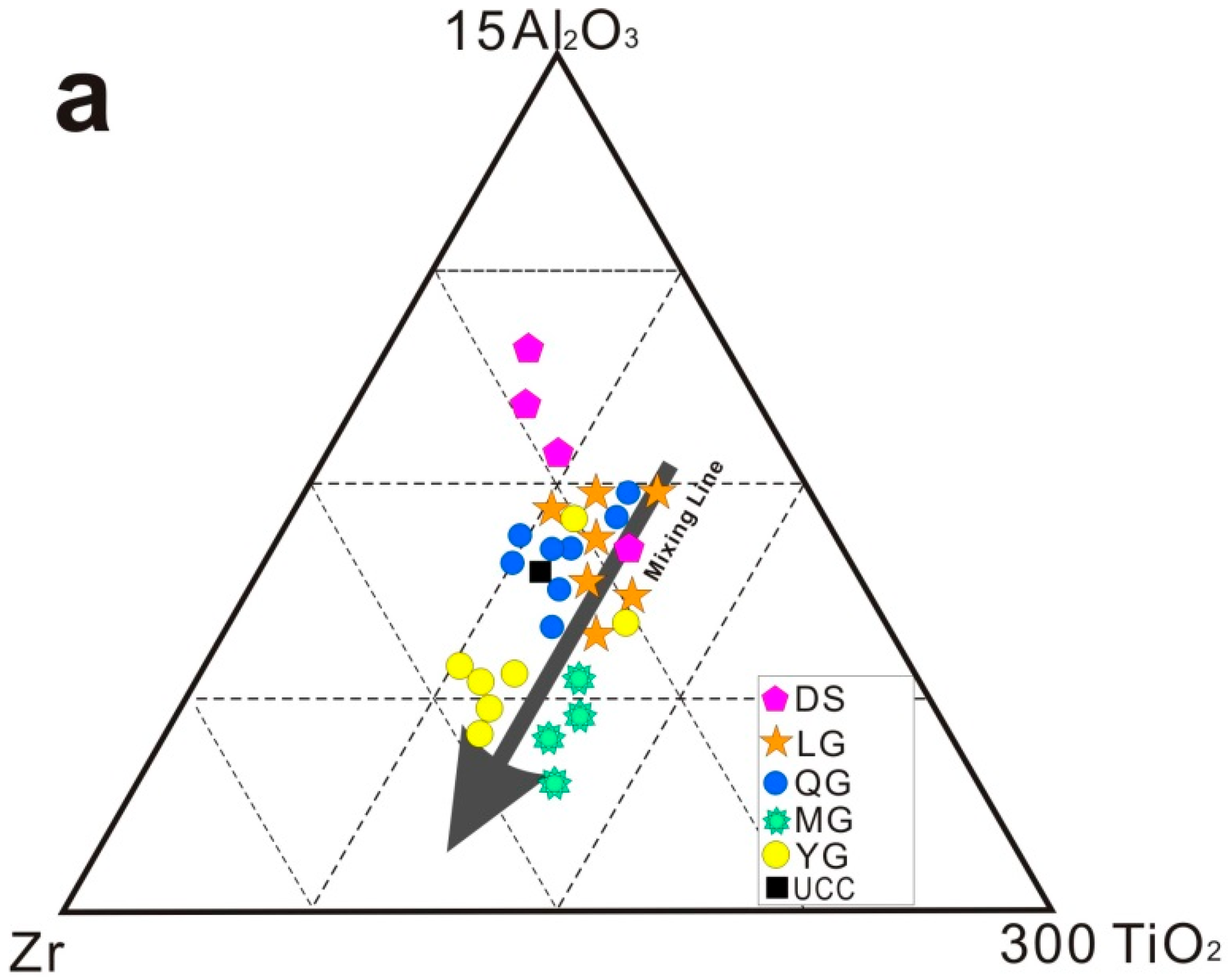
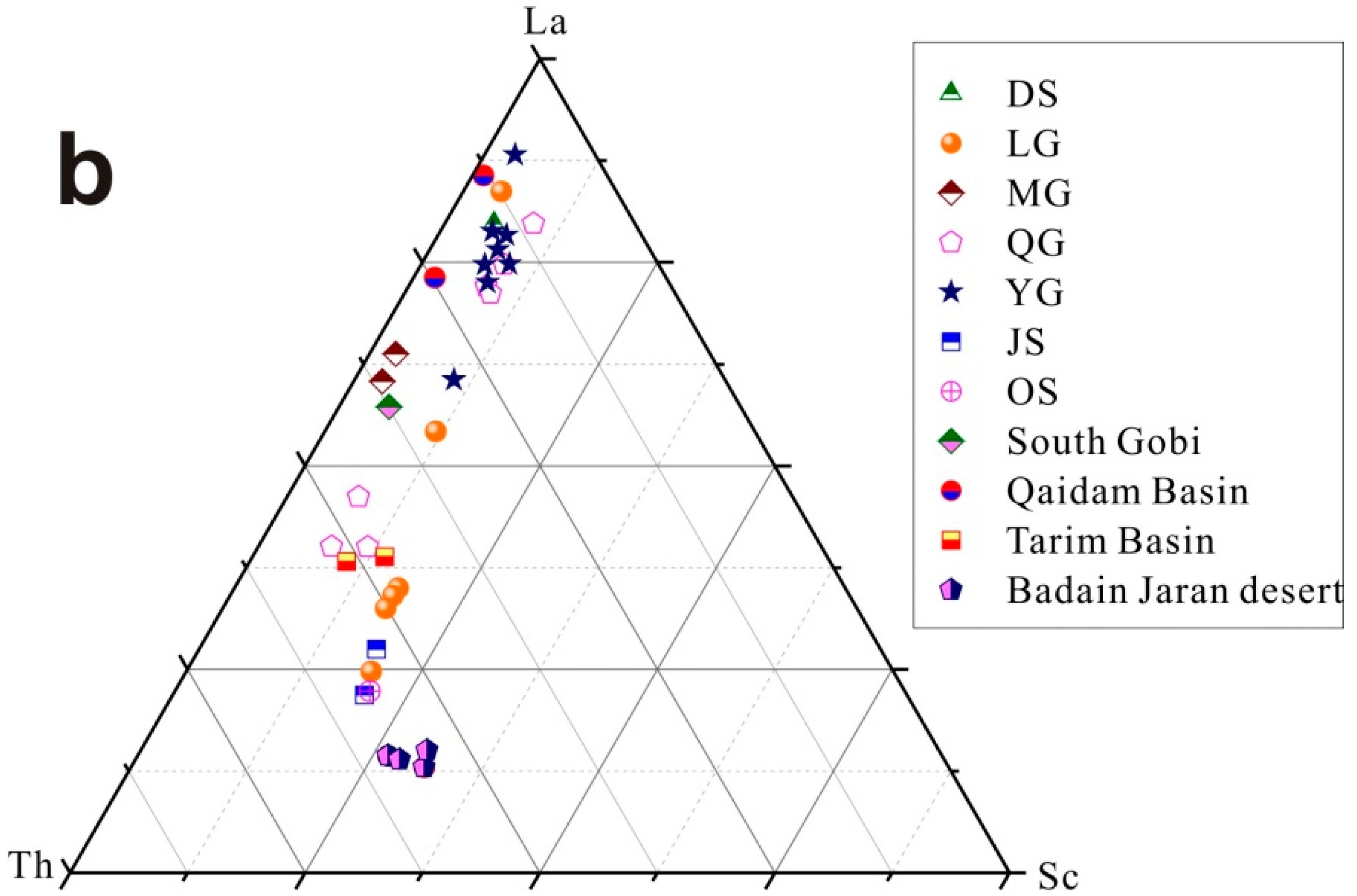
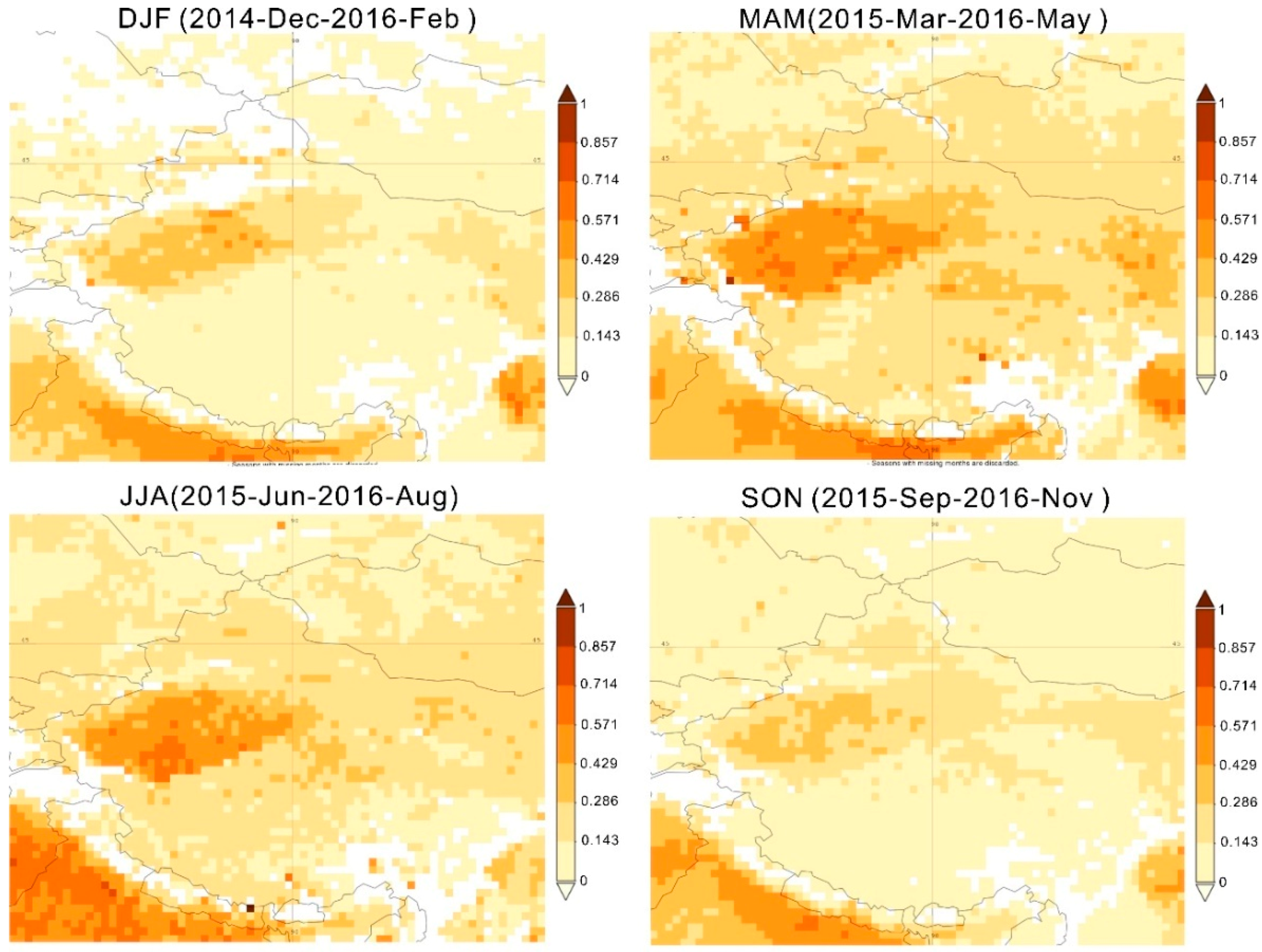
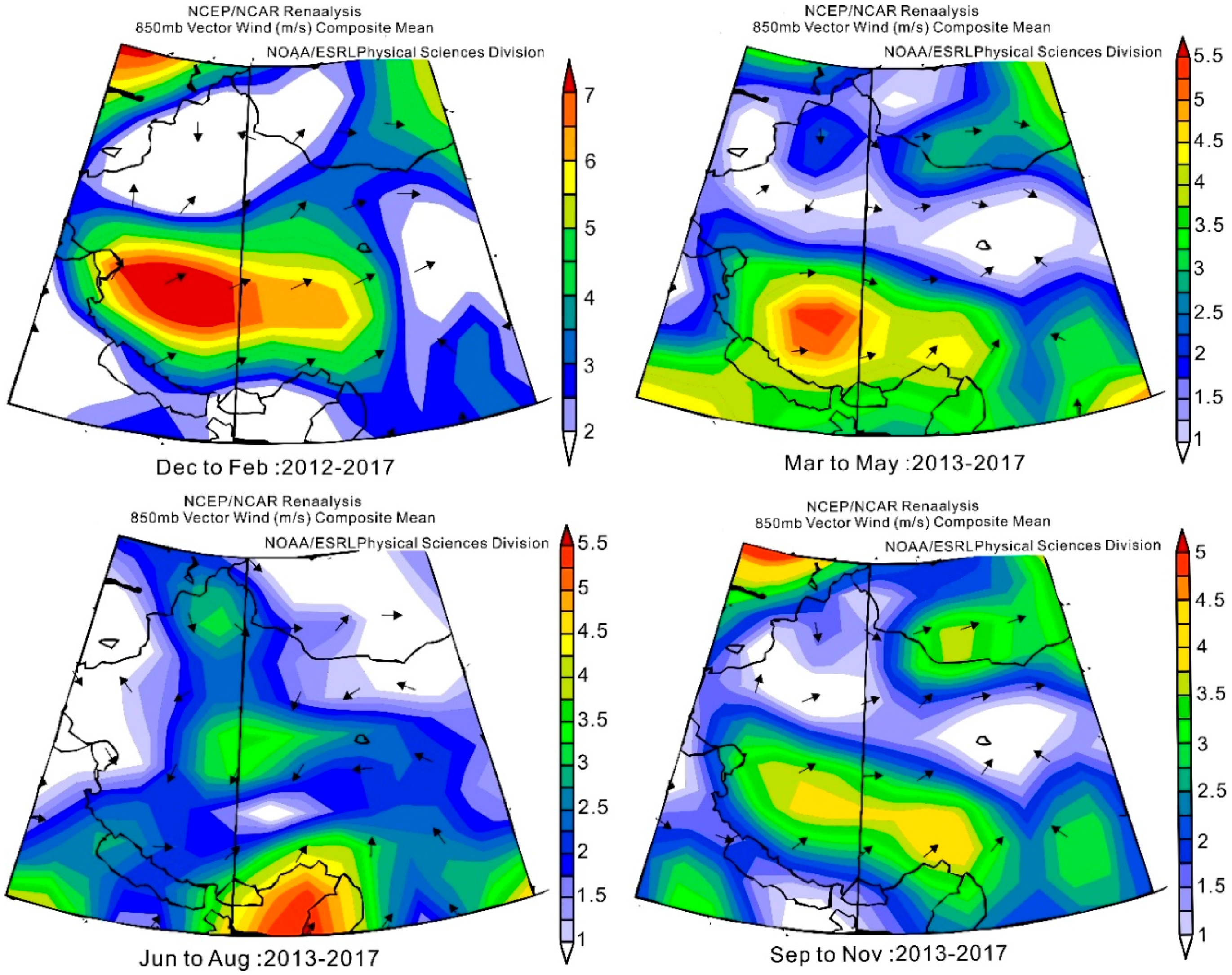
| Location | Mountains | Latitude | Longitude | Altitude | Sample Number | Type |
|---|---|---|---|---|---|---|
| (N) | (E) | m a.s.l | ||||
| Dabanshan Snowpack (DS) | Qilian Mountains | 37°21′ | 101°24 | 2556–3625 | 4 | Snow dust |
| 1 | Surface crust | |||||
| Lenglongling Glacier (LG) | Qilian Mountains | 37°30′ | 101°53′ | 3232–3992 | 8 | Snow dust Cryoconite |
| 1 | Surface crust | |||||
| Qiyi Glacier (QG) | Qilian Mountains | 39°14′ | 97°45′ | 3883–4750 | 9 | Snow dust Cryoconite |
| 1 | Surface crust | |||||
| Miaoergou Glacier (MG) | Tianshan Mountains | 42°59′ | 94°16′ | 3100–3320 | 5 | Snow dust Cryoconite |
| Yuzhufeng Glacier (YG) | Kunlun Mountains | 35°41′ | 94°16′ | 4342–4720 | 8 | Snow dust Cryoconite |
| Ober Ridge (OS) | Qilian Mountains | 37°59′ | 100°55′ | 3685 | 1 | Snow dust |
| 1 | Surface crust | |||||
| Jingyangling Snowpack (JS) | Qilian Mountains | 37°48′ | 101°09′ | 3469 | 2 | Snow dust |
| Golmud | Kunlun Mountains | 36°19 | 95°13′ | 2963 | 1 | Surface crust |
| Hami | Tianshan Mountains | 42°78′ | 93°44′ | 2692 | 1 | Surface crust |
© 2018 by the authors. Licensee MDPI, Basel, Switzerland. This article is an open access article distributed under the terms and conditions of the Creative Commons Attribution (CC BY) license (http://creativecommons.org/licenses/by/4.0/).
Share and Cite
Wei, T.; Dong, Z.; Kang, S.; Ulbrich, S. Tracing the Provenance of Long-Range Transported Dust Deposition in Cryospheric Basins of the Northeast Tibetan Plateau: REEs and Trace Element Evidences. Atmosphere 2018, 9, 461. https://doi.org/10.3390/atmos9120461
Wei T, Dong Z, Kang S, Ulbrich S. Tracing the Provenance of Long-Range Transported Dust Deposition in Cryospheric Basins of the Northeast Tibetan Plateau: REEs and Trace Element Evidences. Atmosphere. 2018; 9(12):461. https://doi.org/10.3390/atmos9120461
Chicago/Turabian StyleWei, Ting, Zhiwen Dong, Shichang Kang, and Sven Ulbrich. 2018. "Tracing the Provenance of Long-Range Transported Dust Deposition in Cryospheric Basins of the Northeast Tibetan Plateau: REEs and Trace Element Evidences" Atmosphere 9, no. 12: 461. https://doi.org/10.3390/atmos9120461
APA StyleWei, T., Dong, Z., Kang, S., & Ulbrich, S. (2018). Tracing the Provenance of Long-Range Transported Dust Deposition in Cryospheric Basins of the Northeast Tibetan Plateau: REEs and Trace Element Evidences. Atmosphere, 9(12), 461. https://doi.org/10.3390/atmos9120461






